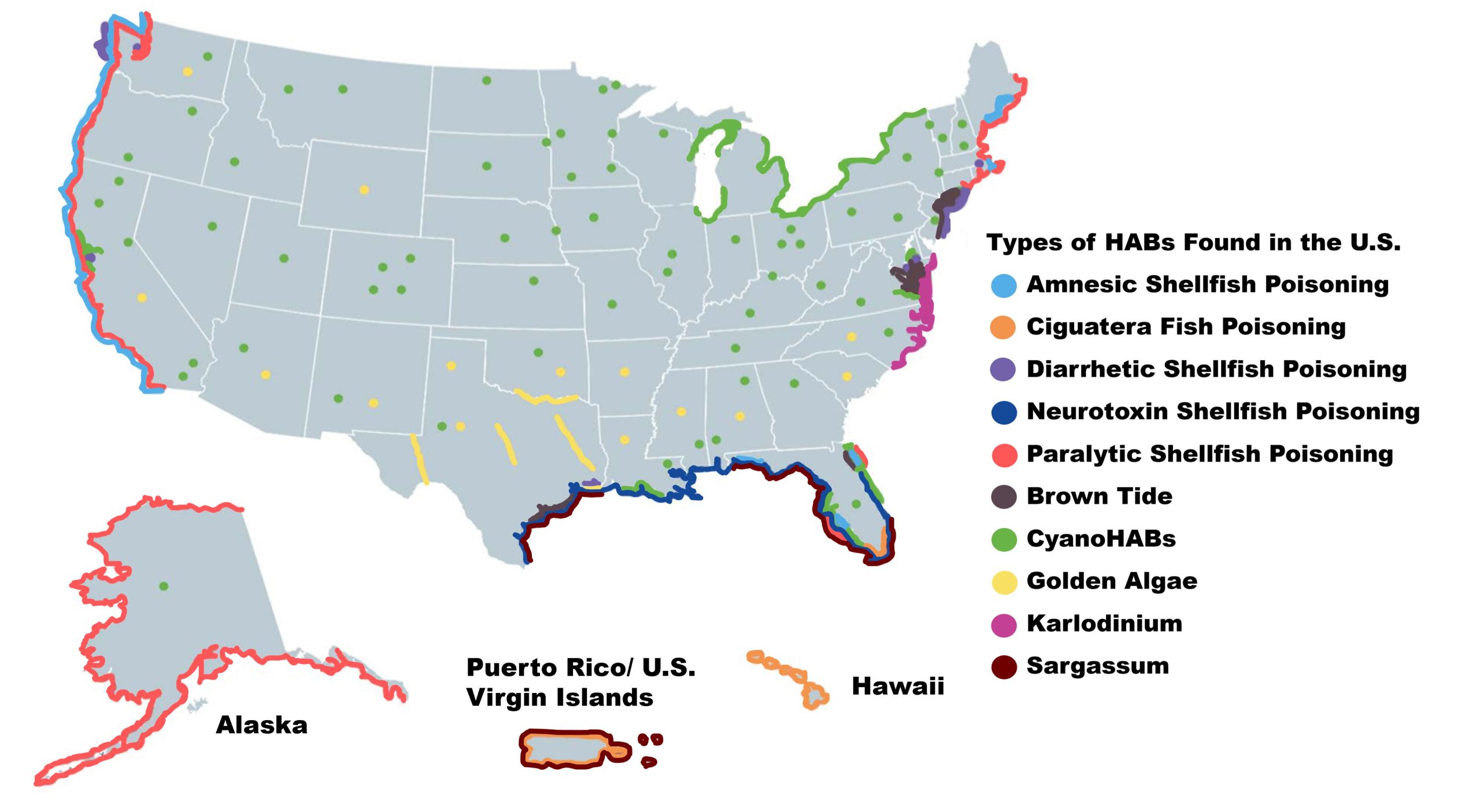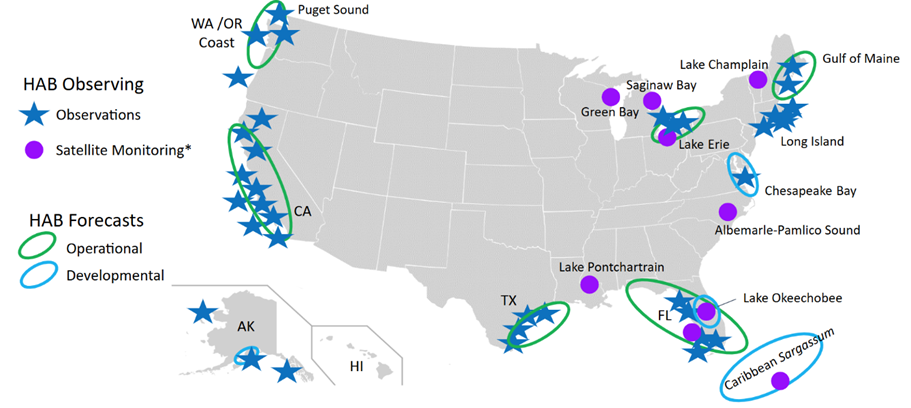Harmful algal blooms (HABs) can have adverse effects on human, animal, and ecosystem health, and cause significant economic impacts to coastal communities. Ranging from single-celled microalgae to large seaweeds, algae are photosynthetic organisms that form the base of aquatic food webs. Various types of algae can cause HABs. Only some of these algae produce toxins some of the time. HABs in marine and freshwater environments are different, but can overlap in estuaries (where rivers meet the sea).

HABs Impact Society and the Environment
Human illnesses caused by HABs are rare, but can be debilitating or even fatal. More than 40 people were treated for paralytic shellfish poisoning from HAB toxins in recreationally harvested mussels on the coast of Oregon in May–June 2024. In July 2020, a person died from paralytic shellfish poisoning after eating blue mussels and snails in Alaska’s Aleutian Islands. Exposure to algal toxins can occur from two main pathways — consumption of contaminated seafood or drinking water, or through breathing aerosolized toxins. States monitor commercially harvested seafood products and drinking water intakes to ensure consumer safety, and close beaches and fisheries if warranted, but subsistence and recreationally harvested seafood is not typically tested for HAB toxins.
Environmental impacts can be linked to toxic and non-toxic HABs. Toxic HAB species can cause fish kills and illness or death in humans, birds, sea turtles and marine mammals as toxins are transferred through the aquatic food web. Non-toxic HABs can adversely impact ecosystems and cause loss of habitat, seagrass die-backs, and hypoxia; introduce pathogens; and alter food web interactions to harm commercially and culturally important species.
Economic impacts from HABs are multi-faceted, including increased public health expenditures, decreased profit from recreation and tourism, commercial and recreational fisheries losses, and increased costs for HAB monitoring and management. The 2015 West Coast Pseudo-nitzschia HAB resulted in $97.5 million in lost Dungeness crab landing revenue. Tourism-related businesses experienced an estimated $2.7 billion loss associated with the 2018 Karenia brevis HAB in Florida.
HAB Distributions are Changing
HABs are naturally occurring, but some HABs are becoming more widespread, frequent, and diverse. Some recurrent HAB events have increased in duration. Freshwater and marine environments have experienced increased nutrient pollution, shifts in precipitation, higher temperatures, altered carbonate chemistry, and increased strengthening and duration of stratification and upwelling, which all impact HABs. Toxic Pseudo-nitzschia events have increased on the U.S. West Coast, with emerging amnesic shellfish poisoning outbreaks in the Northeast U.S. and Gulf of America (formerly Gulf of Mexico). Paralytic shellfish poisoning is a persistent threat in many coastal regions, with disproportionate impacts to subsistence communities in western and northern Alaska. Sargassum inundation has impacted Caribbean, Gulf, and tropical Atlantic coastlines since 2011. Blooms of toxic cyanobacteria occur in all 50 states, and cyanobacterial toxins have been documented in coastal marine ecosystems throughout the U.S. during the past decade.
HAB & Hypoxia Research and Control Act
The Harmful Algal Bloom and Hypoxia Research and Control Amendments Act of 2017 (HABHRCA) requires NOAA and other federal agencies to advance the scientific understanding of and ability to detect, predict, control, mitigate, and respond to HAB events in the U.S. HABHRCA established a national HAB program that coordinates interagency activities on observations, forecasting, prevention and control, and event response. The results are collaborative world-class science, services, and outreach that help protect coastal communities from threats related to HABs.
NOAA’s HAB Services and Research
NOAA advances understanding of HABs and their toxins to improve predictive models and forecasts, detection, monitoring, and control methods, and to inform prevention strategies. NOAA provides timely information on the occurrence of HABs and shares HAB detection, monitoring, and response capacity with states, tribes, industry partners, and other relevant stakeholders.
HAB observing and toxin testing: Coastal resource managers must make timely, informed decisions involving shellfish harvests, beach closures, and remedial actions. NOAA is advancing research on autonomous HAB toxin sensors, laboratory and point-of-use toxin testing, and remote sensing-based observing systems. NOAA’s National HAB Observing Network (NHABON) will integrate local, state, regional, and federal HAB observing capabilities. This shared capacity will strengthen HAB early warnings, discern patterns and trends in HAB occurrence, and provide observations to relevant stakeholders to understand, predict, mitigate, and manage HABs. NOAA and its partners also develop and validate tools and strategies to accurately measure HAB toxins and share toxin testing capacity with regional stakeholders.
HAB forecasting and monitoring: The NOAA HAB Forecasting Network complements NHABON to alert coastal managers to blooms before they cause serious damage. Short-term forecasts identify which blooms may be harmful, where and how widespread they are, and where they may cause harm. Longer-term, seasonal forecasts predict the severity of HABs for the bloom season in a particular region. Early warning of a HAB event provides health officials, environmental managers, and water treatment facility operators with timely information to focus the testing needed to guide water treatment strategies or closures of beaches or shellfish harvest areas. Early warnings also allow the seafood and tourism industries to minimize impacts.
*HAB satellite monitoring products are available in most coastal areas as needs arise.

HAB prevention and control: NOAA aims to understand the environmental and anthropogenic causes of HABs, and their ecological and economic impacts, to inform HAB prevention and mitigate the impacts of HAB events. NOAA scientists and partners are working to control HABs in ways that are safe for people, wildlife, and the environment. NOAA is transitioning environmentally sustainable HAB control technologies that can reduce nutrient pollution, harmful algae, and related toxins, to large-scale operations. Examples include nanobubble ozone technology (NBOT), algicidal bacteria, and modified clay.
Response and readiness for HAB events: Every year, HABs force public health officials to close valuable commercial and recreational seafood harvests and warn people away from popular beaches. NOAA provides coordination, analytical support, and funding to help stakeholders access critical real-time data on HAB species and toxins. These services assist resource managers in making informed decisions to mitigate the impacts of HABs on society, coastal economies, and the environment.
NOAA’s HAB Event Response program has supported on-site partners to respond to 11 HAB events since 2020, resulting in increased availability of rapid testing for HAB toxins, reduced impacts to marine animals, and proactive community outreach and education in regions impacted by HABs.
References:
NOAA State of the Science Fact Sheet: Harmful Algal Blooms (pdf)
All NOAA State of the Science Fact Sheets
Additional resources:
